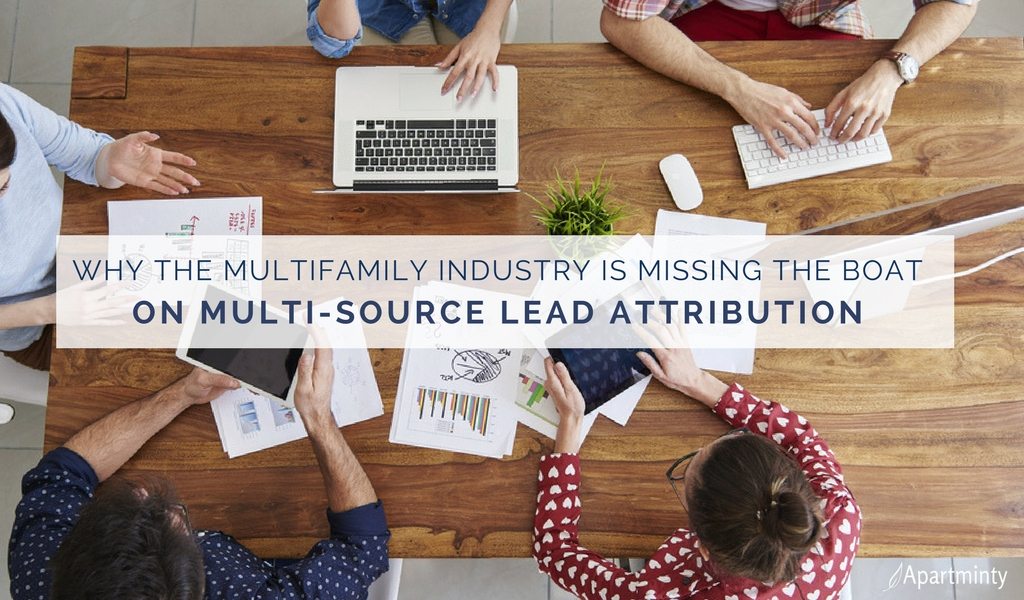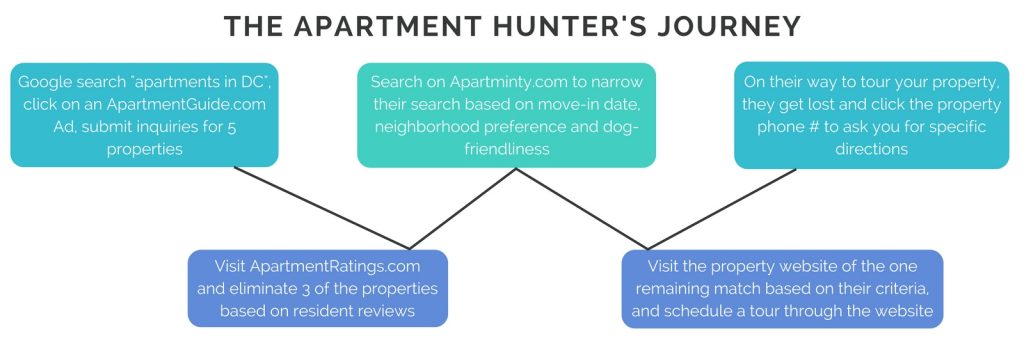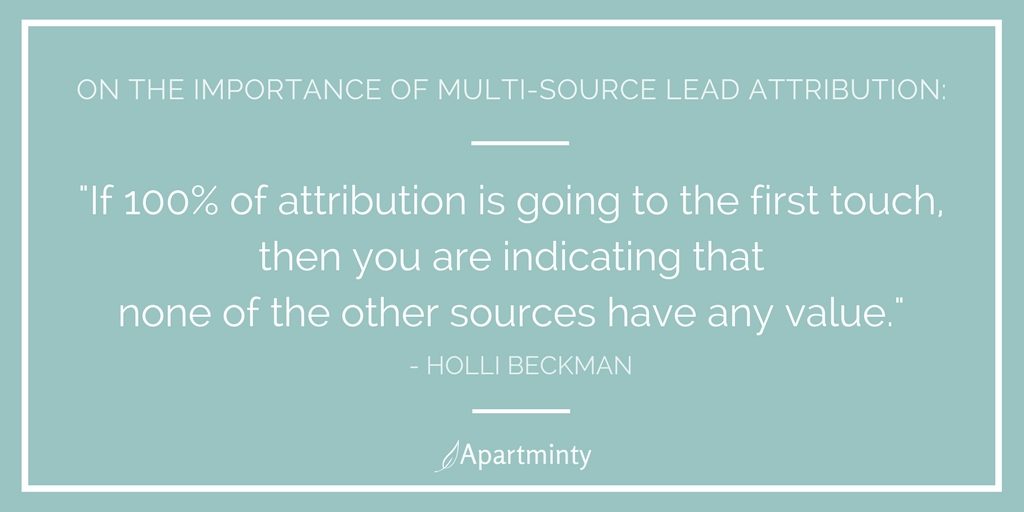
What Is Attribution?
Google defines an attribution model as:
“A rule, or set of rules, that determines how credit for sales and conversions get assigned to touchpoints in conversion paths. For example, the Last Interaction model in Analytics assigns 100% credit to the final touch points (i.e., clicks) that immediately precede sales or conversions.” Source
In marketing, attribution is the identification of a set of user actions (“events” or “touchpoints”) that contribute in some manner to the desired outcome, and then the assignment of a value to each of these events.
So, for most of the multifamily industry, we are looking at what lead sources drove traffic to either our website or through our front door. Some more sophisticated companies are also looking at what actions taken by the leasing team are driving conversions. For this post, we are going to focus on lead source attribution.
What is the problem with Multifamily’s current method of attribution?
For most multifamily marketers, our current method of attribution relies solely on the property management software to assign credit for a lease to an advertising source. As it stands today, the property management software only reports a single source of attribution. In other words, only one source can receive credit for the lease.
I heard an analogy that this likens this to only giving one swimmer on the 1800-meter relay team a medal. That doesn’t seem reasonable.
We know that 50% of renters visit 5 or more websites before they even set foot inside your leasing office. But we only give one source credit for the lease? In single source attribution, you can either choose the first touch or the last touch.
50% of renters visit 5 or more websites before they even set foot inside your leasing office. But we only give one source credit for the lease. TWEET THIS

So let’s imagine a prospective resident’s journey. They Google “apartments in DC” see the ad for ApartmentGuide.com and click it.
Then they find your apartment on AG and send you, and four other properties inquiry leads.
After visiting Apartment Ratings, they eliminate three of the other properties, and now they are just deciding between you and one other place.
They now have a better idea about the specific neighborhood they’re interested in and also realize that some apartments don’t accept pets. They do another apartment search on Apartminty specifying their needs, including move-in date, dog-friendliness, and a desire to be in the Adams Morgan neighborhood.
Your property shows up as a result again. Relieved, they go to your property website, see you have a special on one-bedrooms and submit a lead to schedule a tour.
While on the way to your apartment, they get lost, pull up Google Maps on their phone and click to call you for more detailed directions.
If you are using last touch attribution, Google Maps is getting all the credit for that lease. So when it comes time for budgeting, would you stop all of your other marketing and just be a pin on Google Maps?
Conversely, if you are only using first touch attribution, and giving 100% of the credit to Apartment Guide, you are completely ignoring the importance of monitoring your reputation on Apartment Ratings and Yelp or maintaining your local listings. I mean, if 100% of attribution is going to the first touch, then you are indicating that none of the other sources have any value.

The problem is, this attribution model, be it first touch or last touch still only ascribes the full revenue amount to one single ‘responsible’ channel. As easy as first touch attribution is, it completely overvalues the importance of those ‘top of the funnel’ {ToFu} activities.
As easy as first touch attribution is, it completely overvalues the importance of those ‘top of the funnel’ {ToFu} activities. TWEET THIS
Why does multi-source attribution matter?
We are gravely underestimating the inaccuracy of our data and the effectiveness of our lead sources. Attribution should be informing our decisions, influencing our budgets and guiding our marketing strategy. Instead, the current data we get is barely worth a shoulder shrug and certainly not accurate enough to make business decisions.
Why do we need our property management software companies to step up their attribution game?
Simply put, the data should be pulling from the same place the action is stored. In our case, the signed lease is the close, right? That’s the money action. If we can only measure either the first or last lead source to infer the effectiveness of any marketing campaign, then the weakness in this methodology is compounded by the fact that most multifamily funnels drive prospects to fill out applications on the property website. So if that property is using last touch attribution, we can assume that 85%+ of their leases get attributed to the property website.
If our CRM is housing the customer data, then it should be a near-perfect record of the prospect timeline start to finish. TWEET THIS
Additionally, both leasing agents and marketing teams are familiar with the same software. We could be reading the same reports, and react to the same data. Instead, what we find happening is marketing has to rely on Google Analytics or Hubspot or Marketo to track customer journeys and then reconcile that data with what we see in our Property Management software. Meanwhile, our operations teams are only seeing the Property Management Software reports and saying the phrase that we have heard 100 times. “We don’t get any traffic from that source, let’s cut it.”
If our property management software could provide us reporting for the data already stored in their system, we would no longer have to worry about degradation of data that happens when transferring from one system to another.
We often hear at industry conferences how different departments are trying to break down the silos and work together, but this lack of accurate reporting data drives us to have no choice but to operate in software silos. And if we are operating in different silos there is a good chance we are operating under different assumptions.
What is multi-source attribution and why would that solve the problem?
The days of untargeted marketing efforts should be well behind us. Determining ROI is still one of the Holy Grails as we creep into budgeting season. While Google Analytics can help measure and react to multiple marketing tactics, our property management software has let us down.
While Google Analytics can help measure and react to multiple marketing tactics, our property management software has let us down. TWEET THIS
A marketing team member from a management company of 50,000 units said they just completed a manual “lease match” project that took them over three months to complete and they know they are still not getting the clear picture….what are we doing here people??
We should make decisions based on multi-source attribution modeling, and yet our software doesn’t give us the necessary reporting to complete this task.
What’s more, this is what stifles innovation in the multifamily space. The largest five advertisers own Google’s first page in any metropolitan area. Startups like Zumper, Abodo, and yes, Apartminty but also review sites like Yelp and Apartment Rating that aren’t competing with those Adword spends are rarely going to be the first touch.
But let’s explore the new buyer’s journey. If you know that the initial discovery research phase is to gather information and make a list of every apartment that will work for their generic parameters, then the second step is really about eliminating some of these options. The elimination process is when social proof and the opinions of others start to matter.
The third phase is a confirmation of the decision they’ve made. Someone filling out an application for an apartment does not mean you are not in the clear.
You have to stay top of mind. Staying top of mind is the same reason brands will buy endcap space in Target. It’s often not enough to just see a product on the shelf. But when you see it again, you often will pick it up. You’ve made a bit of a connection, but perhaps you aren’t sold. When you reach the line for the register, and you see it again…that’s when it ends up in your grocery cart.

There are several types of multi-touch attribution. In fact, there are ten prevalent methods. What they have in common is that they distribute credit for the sale amongst several different sources. Where they differ is how they arrive at the weight or percentage that each touch receives as credit.
The most well-known multi attribution models are:
Linear
Time Decay
U shape
W Shape
Linear Multi-Attribution Model
Linear attribution is perhaps the easiest to grasp and to calculate. It assigns equal value to each source that contributed to the sale. So if the prospect-turned-resident contacts you via four unique sources, the sources each receive 25% of that lease. {You take the one lease and divide it by the total number of sources (4). }
1 / 4 = .25 or 25%
While easy to understand and compute, linear attribution does have some faults. It assumes that every source has equal influence over the decision. Instead, other models, as we will explore, take into account the value of a source that pushes the prospect closer to a buying decision. What pushes {initiates, causes/ignites} me to a new stage?
Time Decay Multi-Attribution Model
Time Decay attribution gives the most credit to the most recent interaction. Basically whatever the catalyst to pushing the prospect over the edge to the sale gets the most credit and then it works backward, giving decreasingly less credit to sources the earlier they are in the cycle. While this model makes sense because it lets you know exactly who/what got the prospect to pull the trigger, there is a camp that believes first touch attribution trumps last contact.
“If they never discovered your product during the initial big search, they’d never be researching you further along in the funnel.”
Or as a marketing analyst from a DC firm put it, “I want to know who is showing up on the first page of Google.”
U Shape Multi-Attribution Model
The U shaped attribution model serves to solve for this. It attributes the largest amount of credit to first touch and ‘lead creation’ and then 20% to the activities that fall in between those two things. I don’t think this gives multifamily marketers enough information….especially with as much research as consumers are doing today.
Another challenge for multifamily marketers trying to use U shaped attribution is that First Click Attribution and Lead Conversion Click are practically interchangeable in our property management software because until the prospect has a name, email, or phone number, they do not exist in our CRM. Therefore first touch=lead conversion.
W Shaped Multi-Attribution Model
The W shaped model closely mirrors the prospective resident journey. It assigns 30% credit each to first touch, lead creation, and opportunity creation.
The remaining 10% gets divided amongst the middle touchpoints. If you consider opportunity creation = the property tour, when the sales team takes over and marketing starts to back off, this model starts to make a lot of sense. After the tour, the nurturing of the prospective resident becomes the function and responsibility of the onsite leasing team, not the marketing department.

So a model for us would probably look like:
- Apartments in DC search leads to Adwords {first touch} to
- Apartment Guide website-lead creation, {1 BR’s in DC}
- Apartment Ratings 2nd touch {Ratings for buildings A, B, C, D}, and
- Apartminty 3rd touch {1BR’s in particular neighborhood with pets and ready to move into Oct 1st}
- Property website as last touch {to schedule the tour}.
In this case, attribution would be distributed as follows:
Adwords: 30% first touch
Apartment Guide: 30% lead creation
Apartment Ratings: 5%
Apartminty: 5%
Property Website: 30% opportunity creation
Your individual business practices and capabilities of your marketing team will determine which of these models makes the most sense for you. The one thing we can all agree on is that multi-attribution is necessary for making informed decisions.
With all of these touch points already stored in our property management software, how is the reporting not available to the property management marketers?
Isn’t it time that our software companies stop worrying about Alexa “pay your rent” skills and start delivering data to their paying clients so we can operate as the multimillion dollar portfolio marketers we are?
I’d love to hear from you. What are you using to measure the entire customer journey? Have you customized reports? What’s working? What do you want to see more of?
This is right on point. It’s so frustrating for Marketing Directors, esp. when you know an ILS is delivering leads but the credit goes to the last touch point. The mentality is then “off with their heads” and stop spending, if it’s not delivering. We need to demand better software that helps adapt to our sophisticated buyers. Long gone are the days of buying the front page of the newspaper. It doesn’t work like that anymore. Our buyers are smarter than this and it’s a shame that our industry is lagging behind! We are responsible for multi-million dollar assets, so heed our cry “Property Management Software Companies”, step up and deliver!
Yes! This all day! Single source attribution is antiquated. Multi-source attribution is needed now. The disconnect between how a renter shops and how we are able to attribute the sources is so vast currently, it feels a little like the days of “drive-by” always being #1.
awesome blog Holli, keep preaching!
Great article, although catching it several months later. Does anybody know of any CRM that provides a solution to this? I know in GA we can see several sources for a contact form lead, but for telephone leads it’s virtually impossible.
Hi Carl, Thanks for reading! I am actually beta testing Yardi’s solution. It’s crazy what a difference seeing the bigger picture makes! Let me know if you have questions or any other marketing topics you’d like to read about!
Cheers,
Holli
I think another point to consider with first touch attribution is when the first touch occurred. Here’s a hypothetical scenario, I was looking to rent an apartment 10 yrs ago. As a young person with below average credit, I didn’t qualify for the rental. Now I’m 35, great credit, earning a 6 figure income and find the same property through a different source. 10 yrs later should source A get credit for that lease if i most recently I rediscovered you property via source B??
As marketing professionals we HAVE to start looking at contribution, and not putting all our eggs in the basket of attribution.